Can you take Alpha-Linoleic Acid (ALA) and Alpha-Linolenic Acid (ALA) together?
Interaction Details
Taking Alpha-Linoleic Acid (ALA) and Alpha-Linolenic Acid (ALA) together has the potential for great synergy, suggesting a rating of 5 out of 5.
Explanation of Synergy: Alpha-Linolenic Acid (ALA) is an omega-3 fatty acid found in plant-based foods, and it's also referred to as Alpha-Linoleic Acid in some contexts, though technically, Alpha-Linoleic Acid refers to an omega-6 fatty acid. Assuming the context is about taking two types of omega-3 fatty acids or the intended comparison is between omega-3 and omega-6 fatty acids, the synergy would stem from their combined effects on heart health, inflammation reduction, and brain function. Omega-3 fatty acids, including ALA, support heart health by reducing triglycerides, lowering blood pressure, and preventing blood clots. When taken together, especially if one is an omega-3 and the other an omega-6, they could potentially balance each other out in terms of their effects on inflammation and immune response, as omega-6 fatty acids can promote inflammation in excess but are also necessary for various bodily functions. This balance could lead to improved overall health outcomes, including enhanced heart health and reduced inflammation, although the specific interaction between these supplements would depend on the actual substances being referred to and their precise mechanisms of action.
Potential Benefits
Potential Risks
Alpha-Linoleic Acid (ALA)
Alpha-Linolenic Acid (ALA) is an omega-3 fatty acid found primarily in plant-based foods such as flaxseeds, chia seeds, and walnuts. It is considered an essential fatty acid because the human body cannot produce it on its own.
Alpha-Linolenic Acid (ALA)
Alpha-Linolenic Acid (ALA) is an omega-3 fatty acid found in plant-based foods, playing a crucial role in heart health and inflammation reduction. Some benefits include: * Reduces heart disease risk * Decreases inflammation * Supports brain function
ALA is essential for normal brain function, and its anti-inflammatory properties help reduce the risk of chronic diseases.
